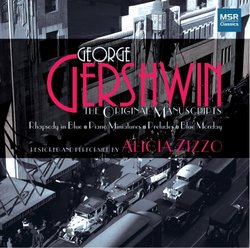| All Artists: Alicia Zizzo Title: George Gershwin: The Original Manuscripts - Rhapsody in Blue Members Wishing: 0 Total Copies: 0 Label: MSR Classics Original Release Date: 1/1/2009 Re-Release Date: 1/20/2009 Genres: New Age, Classical Styles: Instrumental, Opera & Classical Vocal, Chamber Music, Historical Periods, Classical (c.1770-1830) Number of Discs: 1 SwapaCD Credits: 1 UPC: 681585112724 |
Search - Alicia Zizzo :: George Gershwin: The Original Manuscripts - Rhapsody in Blue
 | Alicia Zizzo George Gershwin: The Original Manuscripts - Rhapsody in Blue Genres: New Age, Classical
In every turn of history there exists a kaleidoscope of human expression where new light refracts on old traditions of composition and performance. Because music is an aural art, the penned notation of each work is of cri... more » |
Larger Image |
CD Details
Synopsis
Product Description
In every turn of history there exists a kaleidoscope of human expression where new light refracts on old traditions of composition and performance. Because music is an aural art, the penned notation of each work is of critical importance to its interpretation, and even the silent spaces within that notation become indispensable in shaping rhythm in performance. George Gershwin lived in an era where spaces between the notes literally defined American music. It was called Jazz, and Gershwin weaved magic with it during his short life. Much of that magic was distilled into arrangements, interpretations, editions and performances that went unchanged for more than half a century. Sadly for Gershwin lovers, there were few references to his original manuscripts. And yet Beethoven s or Mozart s or Chopin s works are heard in many recordings from which one can choose a favorite not so with George Gershwin. Gershwin was a born and bred NewYorker, and as Puccini, Tchaikovsky and Paderewski filled its concert halls, the atonalists were decomposing tradition, early jazz players found their niches in sweet-toned, crowded hideaways, and Tin Pan Alley was pumping out mass produced tunes. In their midst was George Gershwin, a happy-go-lucky kid with the genius of Chopin and an incomplete high school education, who passionately immersed himself in every aspect of musical composition. He was also an astute businessman, uneasy with his lack of conservatory training, and as a consequence never developed as an egoist who would dispute the work of editors who often took liberties with his scores. Gershwin greatly benefited from his published editions, however, and although he was happy to perform them from them as well as from his own original manuscripts, his heart and soul rested silently in those neglected piano manuscripts until now.

 Track Listings (16) - Disc #1
Track Listings (16) - Disc #1